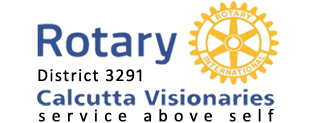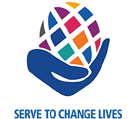
Rotary Club members are business and professional leaders who volunteer in their communities and promote world understanding and peace. Rotary's 31000 Clubs in more than 168 countries and region's encourage high ethical standards and carry out humanitarian projects to address such issues as poverty, health, hunger, education and the environment. Through more than US$ 95 million in Rotary Foundation grants each year. Rotary Clubs support community projects at home and abroad. Known as the world's largest private provider of International Educational Scholarships, The Rotary Foundation funds more than 1,000 students annually to study overseas and act as cultural ambassadors, Rotary also partners with eight prestigious universities around the globe to educate midcareer professionals in peace and conflict resolution
Polio Plus is Rotary's flagship programme. Rotary Club members will contribute US$ 600 million and countless volunteer hours to help immunize over two billion children against polio. Spearheading partners in the global polio eradication initiative include the World Health Organization, Rotary International, US Centers for Disease Control and Prevention and UNICEF.
Founded in Chicago in 1905 as the World's first volunteer service organization Rotary quickly expanded around the globe. Clubs meet weekly for fellowship to discuss local and global issues. Clubs are nonreligious, nongovernmental and open to every race, culture and creed.
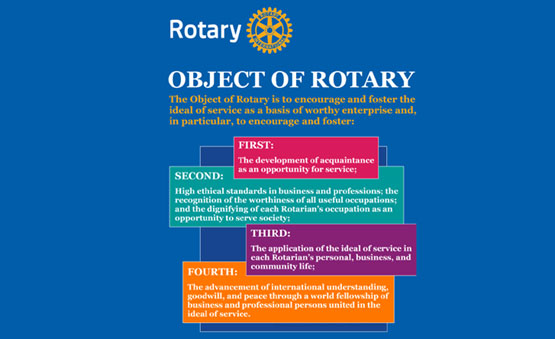
The object is to encourage and foster the ideal of service as a basis of worthy enterprise and, in particular, to encourage and foster.
First :
The development of acquaintance as opportunity for service;
Second :
High ethical standard in business and professions; the recognition of the worthiness of all useful occupations; and the dignifying of each Rotarian of his occupation as an opportunity to serve society;
Third :
The application of the ideal of service by every Rotarian his personal, business and community life;
Fourth :
The advancement of international understanding, goodwill and peace through a world fellowship of business and professional persons united in the ideal of service.
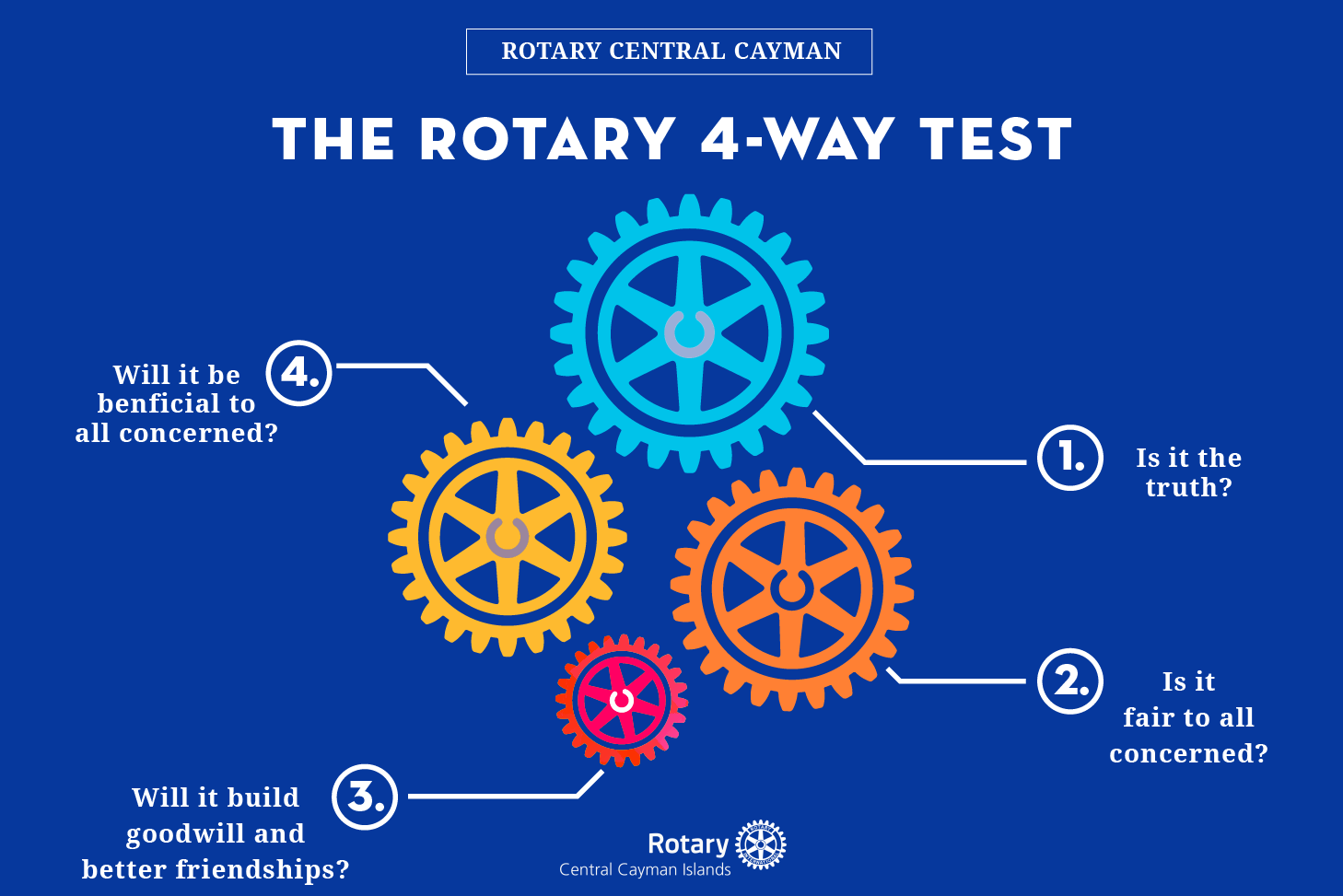
In 1932, Rotarian Herbert J. Taylor created The Four-Way Test, a code of ethics adopted by Rotary 11 years later. The test, which has been translated into more than 100 languages, asks the following questions:
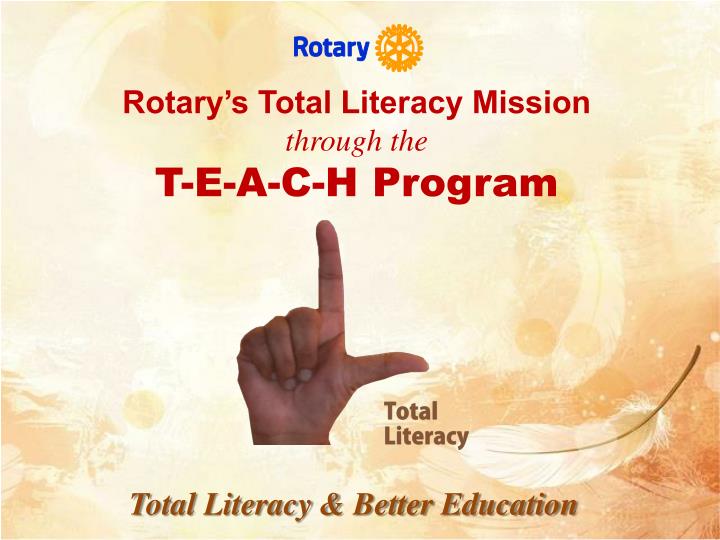

Dollars and some good financial sense are the reasons who Rotary Year starts on 1st July, at least that is what RI auditors said, according to 1912-13 RI President Glenn C Meads report in the September 1912-13 issue of The Rotarian.
Auditors found that the organisations affairs had been managed honestly and carefully., Still RI was growing and had recently become an International organization and its needs were changing.
The Secretary and Treasurer needed some more time to prepare, audit and check the organisations financial statements by the end of the calendar year. The auditors recommended that the organization close its financial books for the year on 30 June which was after the RI Convention. The Board of Directors agreed and ever since the Rotary Year has begun on 1 July.

Historic Moments – Rotary Motto’s
Arthur Frederick Sheldon, the Rotarian whose convention speech inspired Rotary's secondary motto, One Profits Most Who Serves Best.
Rotary's official mottoes, Service Above Self and One Profits Most Who Serves Best, trace back to the early days of the organization.
In 1911, He Profits Most Who Serves Best was approved as the Rotary motto at the second convention of the National Association of Rotary Clubs of America, in Portland, Oregon. It was adapted from a speech made by Rotarian Arthur Frederick Sheldon to the first convention, held in Chicago the previous year. Sheldon declared that “only the science of right conduct toward others pays. Business is the science of human services. He profits most who serves his fellows best.”
The Portland convention also inspired the motto Service Above Self. During a convention outing on the Columbia River, Ben Collins, president of the Rotary Club of Minneapolis, Minnesota, USA, talked with Seattle Rotarian J. E. Pinkham about the proper way to organize a Rotary Club, offering the principle his club had adopted: Service, Not Self. Pinkham invited Paul P. Harris, who also was on the boat trip, to join their conversation. Harris asked Collins to address the convention, and the phrase Service, Not Self was met with great enthusiasm.
At the 1950 RI Convention in Detroit, slightly modified versions of the two slogans were formally approved as the official mottoes of Rotary : He Profits Most Who Serves Best and Service Above Self. The 1989 Council on Legislation established Service Above Self as the principal motto of Rotary, because it best conveys the philosophy of unselfish volunteer service., He Profits Most Who Serves Best was modified by the 2004 Council to They Profit Most Who Serve Best and by the 2010 Council to its current wording. One Profits Most Who Serves Best.
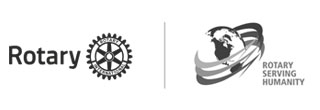
The first motto of Rotary International, “He Profits Most Who Serves Best” was approved at the second Rotary convention, held in Portland, Oregon, in August 1911. The phrase was first stated by a Chicago Rotarian, Art Sheldon, who made a speech in 1910 which included the remark, “He Profits most who serves his fellows best”. At about the same time Ben Collins, president of the Rotary Club of Minneapolls, Minnesota, commented that the proper way to organize a Rotary Club was through the principle his club had adopted – “Service, Not Self”. These two slogans, slightly modified were formally approved to be the official motto of Rotary at the 1915 Convention in Detroit ”He Profits most who serves best” and “Service above self”. The 1989 Council on legislation established “Service above self” as principal motto of Rotary, since it best explains the philosophy of unselfish voluntary service.

The most notable current globe project, Polio Plus, is contributing to the global eradication of polio. Since beginning the project in 1985, Rotarians have contributed over US$ 850 million and tens of thousands of volunteer-hours, leading to the inoculation of more than two billion of the world's children. Inspired by Rotary's commitment, the World Health Organization (WHO) passed a resolution in 1988 to eradicate polio by 2000. Now a partner in the Global Polio Eradication Initiative (GPEI) with WHO, UNICEF and the US Centers, Rotary is recognized by the United Nations as the key private partner in the eradication effort.
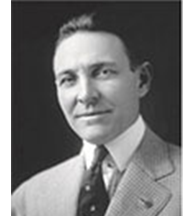
In 1917, RI President Arch C. Klumph proposed that an endowment be set up “for the purpose of doing good in the world”. In 1928, when the endowment fund had grown to more than US $ 5,000. It was renamed The Rotary Foundation, and it became a distinct entity within Rotary International.
Five Trustees, including Klumph, were appointed to “hold, invest, manage and administer all of its property as a single trust, for the furtherance of the purposes of RI”.
Two years later, the Foundation made its first grant of $ 500 to the International Society for Crippled Children. The organization, created by Rotarian Edgar F. “Daddy” Allen, later grew into the Easter Seals.
The Great Depression and World War II both impeded the Foundation's growth, but the need for lasting world peace generated great postwar interest in its development. After Rotary's founder, Paul P. Harris, died in 1947, contributions began pouring into Rotary International, and the Paul Harris Memorial Fund was created to build the Foundation.
That year, the first Foundation program – the forerunner of Rotary Foundation Ambassadorial Scholarships – was established. In 1965-66, three new programs were launched : Group Study Exchange, Awards for Technical Training, and Grants for Activities in Keeping with the Objective of The Rotary Foundation, which was later called Matching Grants.
The Health, Hunger and Humanity (3-H) Grants program was launched in 1978, and Rotary Volunteers was created as a part of that program in 1980. Polio Plus was announced in 1984-85, and the next year brought Rotary Grants for University Teachers. The first peace forums were held in 1987-88, leading to the Foundation's peace and conflict studies programs.
Throughout this time, support of the Foundation grew tremendously. Since the first donation of $ 26.50 in 1917, it has received contributions totaling more than $ 1 billion. More than $ 70 million was donated in 2003-04 alone. To date, more than one million individuals have been recognized as Paul Harris Fellows – people who have given $ 1,000 to the Annual Programs Fund or have had that amount contributed in their name.
Such strong support, along with Rotarian involvement worldwide, ensures a secure future for The Rotary Foundation as it continues its vital work for international understanding and world peace.

The world's first service club, the Rotary Club of Chicago, was formed on 23 February 1905 by Paul P. Harris, an attorney who wished to capture in a professional club the same friendly spirit he had felt in the small towns of his youth. The Rotary name derived from the early practice of rotating meetings among members' offices.
Rotary's popularity spread, and within a decade, clubs were chartered from San Francisco to New York to Winnipeg, Canada. By 1921, Rotary Clubs had been formed on six continents. The organization adopted the Rotary International name a year later.
As Rotary grew, its mission expanded beyond serving club members' professional and social interests. Rotarians began pooling their resources and contributing their talents to help serve communities in need. The organization's dedication to this ideal is best expressed in its motto : Service Above Self.
By 1925, Rotary had grown to 200 Clubs with more than 20,000 members. The organization's distinguished reputation attracted presidents, prime ministers, and a host of other luminaries to its ranks – among them author Thomas Mann, diplomat Carlos P. Romulo, humanitarian Albert Schweitzer, and composer Jean Sibelius.
During World War II, many clubs were forced to disband, while others stepped up their service efforts to provide emergency relief to victims of the war, in 1942, looking ahead to the postwar era, Rotarians called for a conference to promote international educational and cultural exchanges. This event inspired the founding of UNESCO.
In 1945, 49 Rotary Club members served in 29 delegations to the UN Charter Conference, Rotary still actively participates in UN conferences by sending observers to major meetings and covering the United Nations in its publications.
“Few there are who do not recognize the good work which is done by Rotary Clubs throughout the free world”, former Prime Minister Winston Churchill of Great Britain once declared.
As it approached the 21st Century, Rotary worked to meet society's changing needs, expanding its service efforts to address such pressing issues as environmental degradation, illiteracy, world hunger, and children at risk.
In 1989, the organization voted to admit women into clubs worldwide and now claims more than 145000 female members in its ranks.
After the collapse of the Berlin Wall and the dissolution of the Soviet Union, Rotary Clubs were formed or re-established throughout Central and Eastern Europe. The first Russian Rotary Club was chartered in 1990, and the organization underwent a growth spurt for the next several years.
More than a century after Paul Harris and his colleagues chartered the Club that eventually led to Rotary International, Rotarians continue to take pride in their history. In honor of that first Club, Rotarians have preserved its original meeting place, Room 711 in Chicago's Unity Building, by re-creating the office as it existed in 1905. For several years, the Paul Harris 711 Club maintained the room as a shrine for visiting Rotarians. In 1989, when the building was scheduled to be demolished, the Club carefully dismantled the office and salvaged the interior, including doors and radiators. In 1993, the RI Board of Directors set aside a permanent home for the restored Room 711 on the 16th floor RI World Headquarters in nearby Evanston.
Today, 1.2 million Rotarians belong to over 32,000 Rotary Clubs in more than 200 countries and geographical areas.
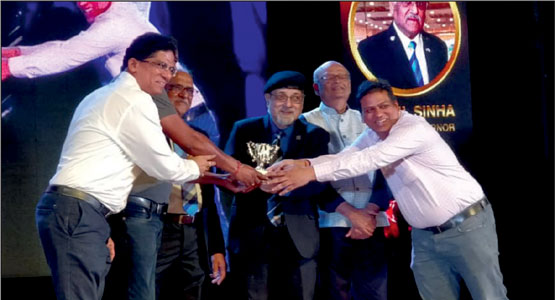
CALCUTTA was the home town for the first Rotary Club in the mainland of Asia. RJ Combes, while on a business trip to USA was so impressed by the “Friendship, fellowship and service” aspects of the movement called Rotary that he wanted to introduce the idea to his friends in Calcutta also. He found no difficulty in finding like minded individuals and thus convenes the first meeting on 26th September, 1919.
The new club was chartered just after three months of the first meeting, on the New Year day of 1920 to be exact. All the twenty charter members were non-Indians. The first Indian member was S. C. Rudra who was inducted in 1921. In 1921 itself Sir Surendernath Banerjee was made an honorary member. The first Indian to become the Club Secretary was Nitish C. Laharry (1926) who climbed all steps to reach Rotary's top slot viz. RI Presidentship in 1962-63. AFM Abdul Ali was the first Indian to adorn the collar of a Club President.
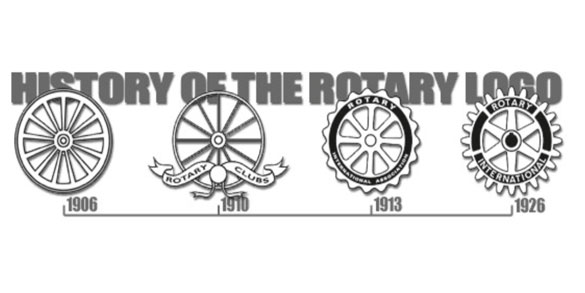
The Rotary emblem, unchanged since 1924, was redesigned many times in the early years of the organization. In 1905, Montague M. Bear, an engraver and member of the Rotary Club of Chicago, sketched a wagon wheel with 13 spokes. The emblem was modified in the years 1906, 1910, 1912 and 1920. In January 1924, the Board formally approved the emblem that was then in use. Not all written descriptions were updated immediately. To clear up any confusion caused by the various decisions about the emblem between 1912 and 1929, a standard description of the existing design, with a keyway, was approved by the 1929 convention.
| Year | President | Theme |
| 1956-1957 | Gain Paolo Lang | 3 Targets - Keep Rotary Simple, More Rotary in Rotarians, Learn More About Each Other. |
| 1957-1958 | Charles G. Tennent | Enlist - Extend - Explore - Serve. |
| 1958-1959 | Clifford A. Randall | Help Shape the Future. |
| 1959-1960 | Harold T. Thomas | Vitalize! Personalize! Build Bridges of Friendship. |
| 1960-1961 | J. Edd McLaughlin | You are Rotary - Live it! Express it! Expand it! |
| 1961-1962 | Joseph A. Abet | Act, Aim for Action, Communicate for, Understanding, Test for Leadership. |
| 1962-1963 | Nitish C. Laharray | Kindle the Spark within. |
| 1963-1964 | Cart P. Miller | Meeting Rotary's challenge in the Space Age. |
| 1964-1965 | Charles W. Pattengill | Live Rotary. |
| 1965-1966 | C. P. H. Teenstra | Action, Consolidation and Continuity. |
| 1966-1967 | Richard L. Evans | A better World through Rotary. |
| 1967-1968 | Luthur H. Hodges | Make your Rotary Membership effective. |
| 1968-1969 | Kyshi Togasaki" | Participate. |
| 1969-1970 | James F. Conway | Review and Renew. |
| 1970-1971 | William E. Walk | Bridge the Gaps. |
| 1971-1972 | Emst G. Breithoitz | Goodwill begins with you. |
| 1972-1973 | Roy D. Hickman | Let's take a new look and act. |
| 1973-1974 | William C. Carter | A Time for Action. |
| 1974-1975 | William R. Robbins | Renew the Spirit of Rotary. |
| 1975-1976 | Erenesto Imbassahy de Mello | To dignify the human being. |
| 1976-1977 | Rober Manchester II | I believe in Rotary. |
| 1977-1978 | W. Jack Davis | Serve to unite Mankind. |
| 1978-1979 | Clem Renour | Reach out. |
| 1979-1980 | James L. Bomar(Jr.) | Let Service Light the Way. |
| 1980-1981 | Rolf J. Klarich | Take time to Serve. |
| 1981-1982 | Stanley E. Mccaffray | World understanding and peace through Rotary. |
| 1982-1983 | Hiroji Mukasa | Mankind is one - Build Bridges of Friendshipt hroughout the world. |
| 1983-1984 | William E. Skelton | Share Rotary Serve People. |
| 1984-1985 | Carlos Canseco | Discover a New World of Service. |
| 1985-1986 | Edward F. Cadman | You are the Key. |
| 1986-1987 | MAT. Caparas | Rotary Brings Hope. |
| 1987-1988 | Chares C. Keller | Rotarians - United in Service, Dedicated to Peace. |
| 1988-1989 | H. Royce Abbey | Put life into Rotary - Your Life. |
| 1989-1990 | Hugh M. Archer | Enjoy Rotary. |
| 1990-1991 | Paul V. C. Costa | Honour Rotary with faith and entusiasm. |
| 1991-1992 | Rajendra K. Saboo | Look Beyond Yourself. |
| 1992-1993 | Clifford Dochterman | Real Happiness is in helping others. |
| 1993-1994 | Robert R. Barth | Believe in wht you do Do what you believe in. |
| 1994-1995 | Bill Huntley | Be a Friend. |
| 1995-1996 | Herbert G. Brown | Act with Integrity, Serve with Love, Work for Peace. |
| 1996-1997 | Luls Vicente Giay | Build the future with Action & Vision. |
| 1997-1998 | Glen W. Kinross | Show Rotary Cares. |
| 1998-1999 | James L. Lacy | Follow Your Rotary Dream. |
| 1999-2000 | Carlo Rvizza | Act with Consistency, Credibility, Continuity. |
| 2001-2002 | Richard D. King | Mankind is our Business. |
| 2002-2003 | Bhichal Rattakul | Sow the Seeds of Love. |
| 2003-2004 | Jonathan B. Bajiyagbe | Lend A Hand. |
| 2004-2005 | Glenn E Estess Sr. | Celebrate Rotary. |
| 2005-2006 | Cart-Withelm Stenhammar | Service Above Self. |
| 2006-2007 | William B. Boyd | Lead The Way. |
| 2008-2009 | D. K. Lee | Make Dreams Real. |
| 2009-2010 | John Kenny | The Future of Rotary is in your hands. |
| 2010-2011 | Ray Klinginsmith | Building Communities, Bridging Continents. |
| 2011-2012 | Kalyan Banerjee | Reach within to Embrace Humanity. |
| 2012-2013 | Sakuji Tanaka | Peace "Through Service. |
| 2013-2014 | Ron D. Bruton | Engage Rotary Change Lives. |
| 2014-2015 | Gary C. K. Hang | Light up Rotary. |
| 2015-2016 | K. R. Ravindran | Be A Gift To th World. |
| 2016-2017 | John F. Germ | Rotary Serving Humanity. |
| 2017-2018 | Ian Riseley | Rotary Making a Difference. |
| 2018-2019 | Barry Rassin | Be the Inspiration. |
